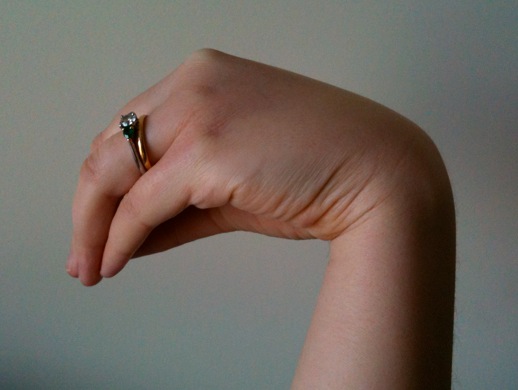Playlist
Show Playlist
Hide Playlist
Acute Hypocalcemia
-
Slides Hypocalcemia EndocrinePathology.pdf
-
Reference List Pathology.pdf
-
Download Lecture Overview
00:01 Acute Hypocalcemia: Presentation… you’ll have your tetany, extreme irritated-irritability. 00:06 We talked about paresthesia, especially perioral-oral, when we talked about it in carpopedal spasms, also Chvostek’s sign. 00:13 In the motor issue, we have stiffness and clumsiness, myalgia, muscle spasm and cramps… myalgia. 00:21 Hands may show forced adduction of the thumb, flexion of the metacarpophalangeal joint and wrists and extension of the fingers. 00:29 So, kind of looks like this that I’m showing you, this is due to hypocalcemia. 00:36 The spasms of respiratory muscle and of the glottis so then refer-referred to as being your laryngismus or stridulus can cause cyanosis. 00:50 Continuing the tetany and the irritability, cardiovascular, hypotension, decreased cardiac contractility because of extreme twitching not only skeletal muscles, but perhaps even in the heart. 01:01 There might be prolonged QT syndrome or read about prolonged QT interval resulting in long QT syndrome. 01:08 And once again, not only would you have spasms in the skeletal muscle, cardiac muscle, but then also pulmonary may result in bronchospasm. 01:17 As I told you earlier, there might be difficulty with breathing and so, therefore, may result in bronchospasms and sinuses. 01:25 What we see here is a patient on your left who, upon tapping of the facial nerve, resulted in twitching of the eyes, the nose and the mouth. 01:39 This, on your left, is positive Chvostek’s sign; on the right, it’s recovery from the tetany. 01:47 There’s something called Trousseau’s sign exactly as to what we talked about earlier. 01:52 A flexion of the wrist, flexion of metacarpophalangeal and extension of the fingers just a little bit. 01:59 We call this Trousseau’s sign. 02:01 Carpopedal spams elicited by placing a blood pressure cuff around your arm resulting in Trousseau’s sign or carpopedal spasms. 02:12 Do not forget about the circumoral numbness that may also be associated with your hypocalcemia. 02:19 Evaluation, diagnosis, clinical presentation. 02:24 Post neck surgery, just in case the surgery then reveals to you, “Oh, yeah, it might be hypocalcemia maybe because of surgery”; decreased calcium, increased phosphate; magnesium will be altered. 02:38 PTH maybe perhaps decreased and Vitamin D perhaps decreased. 02:42 Important, important laboratory values that you want to keep in mind so that you are able to steer your diagnosis in the correct direction. 02:54 Severe hypocalcemia in symptomatic patients treated with slowly administered IV calcium gluconate or calcium chloride. 03:04 You pay attention to calcium gluconate. 03:06 Mild cases are treated with oral calcium carbonate or calcium citrate usually in conjunction with Vitamin D. 03:13 Hypoparathyroid patients require activated Vitamin D calcitriol because without that PTH, there’s absolutely no way that the 1-alpha-hydroxylase will be activated, thus rendering your patient Vitamin D deficient.
About the Lecture
The lecture Acute Hypocalcemia by Carlo Raj, MD is from the course Parathyroid Gland Disorders.
Included Quiz Questions
Paresthesias in which area is indicative of acute hypocalcemia?
- Perioral
- Periorbital
- Cape-like over the neck and back
- Stocking glove distribution (over the hands and feet)
- Truncal
What is NOT a characteristic sign of acute hypocalcemia?
- Decreased reflexes
- Prolonged QT on ECG
- Laryngismus stridulous
- Hands in forced adduction of thumb and flexion of the wrist
- Trousseau's sign
Which regimen is administered to correct hypocalcemia in patients with hypoparathyroidism?
- IV or oral calcium with calcitriol
- IV or oral calcium with PTH
- IV or oral vitamin D with PTH
- IV or oral calcium with inactive vitamin D
- IV calcium only
Customer reviews
5,0 of 5 stars
| 5 Stars |
|
5 |
| 4 Stars |
|
0 |
| 3 Stars |
|
0 |
| 2 Stars |
|
0 |
| 1 Star |
|
0 |




